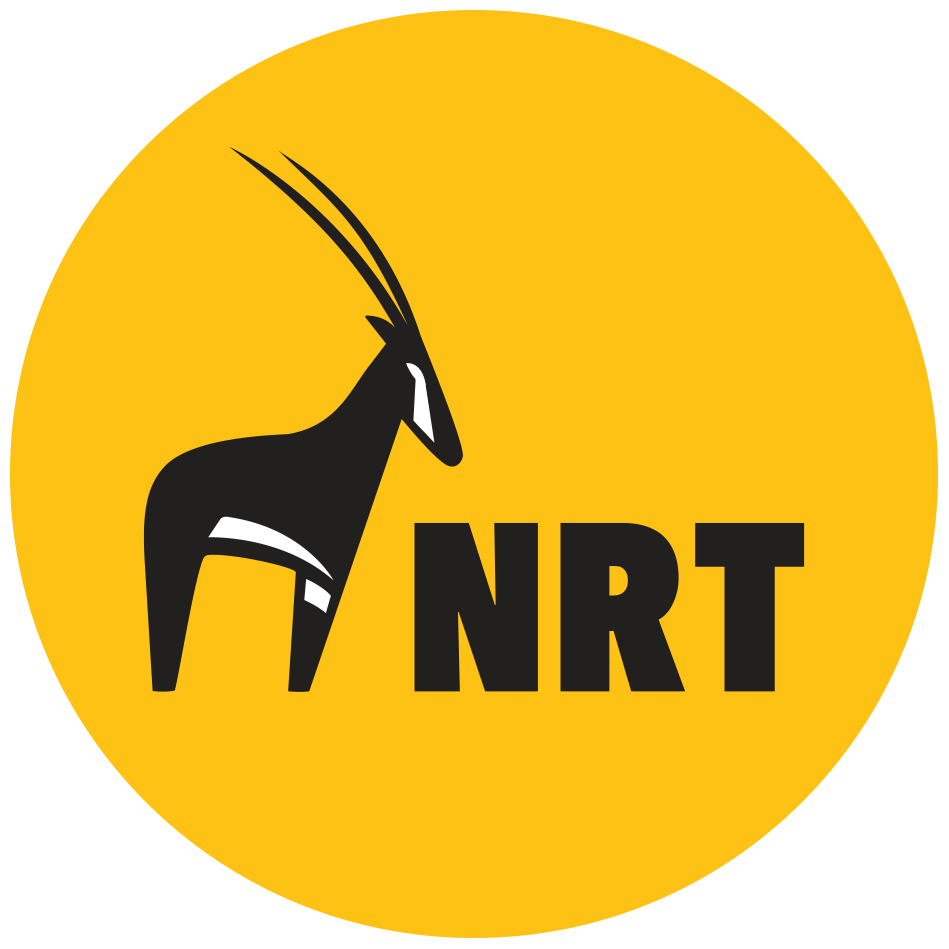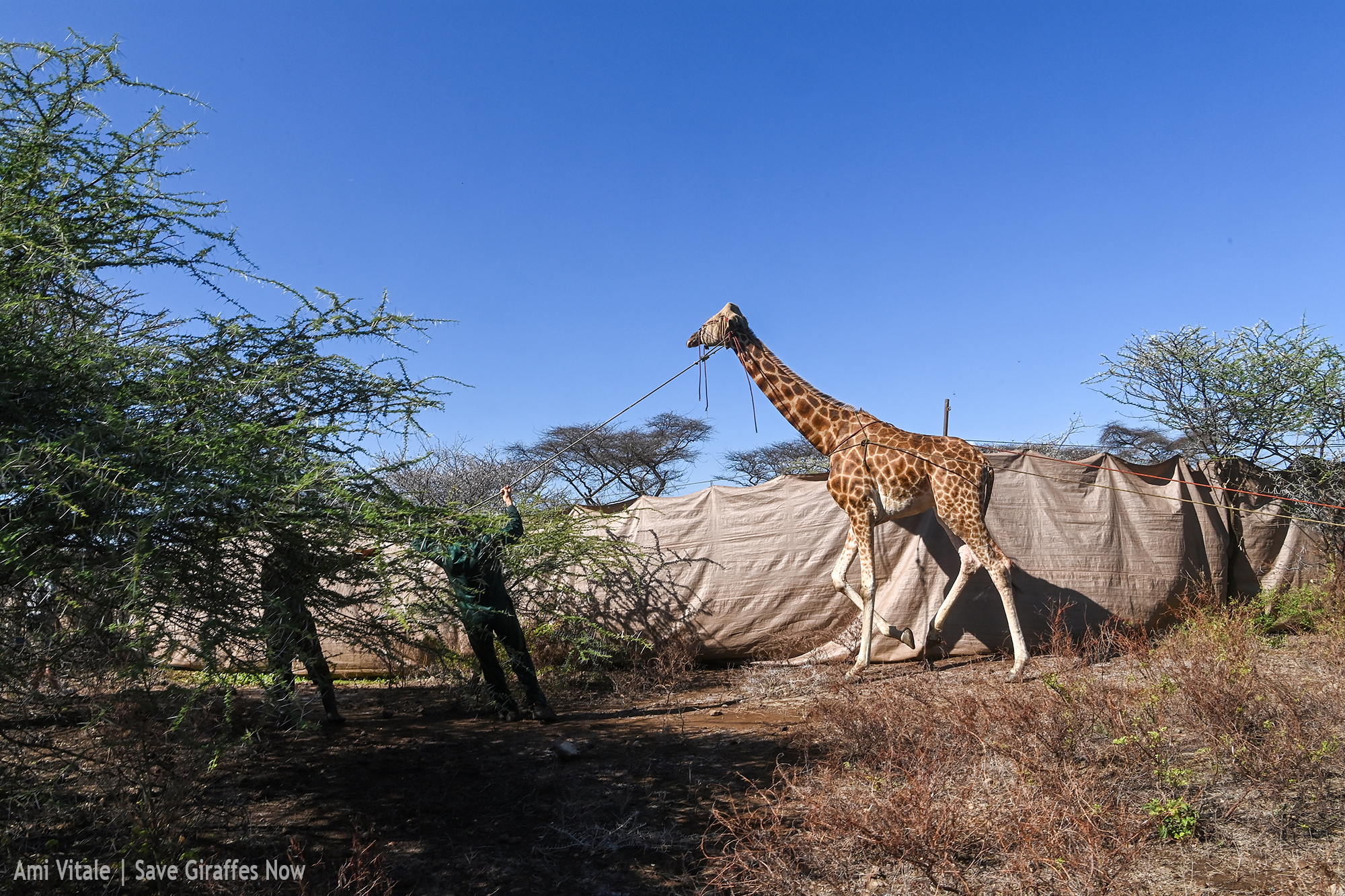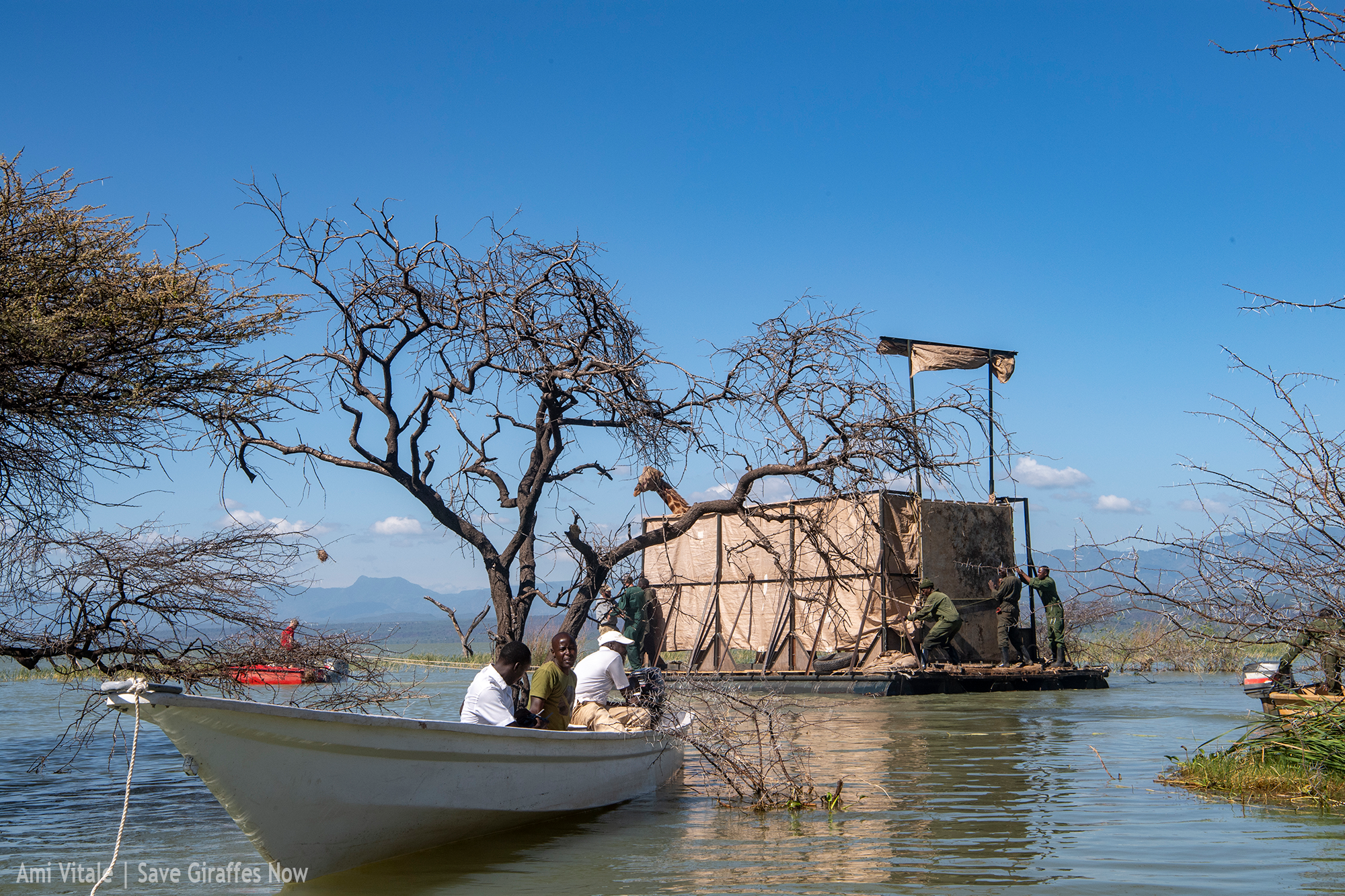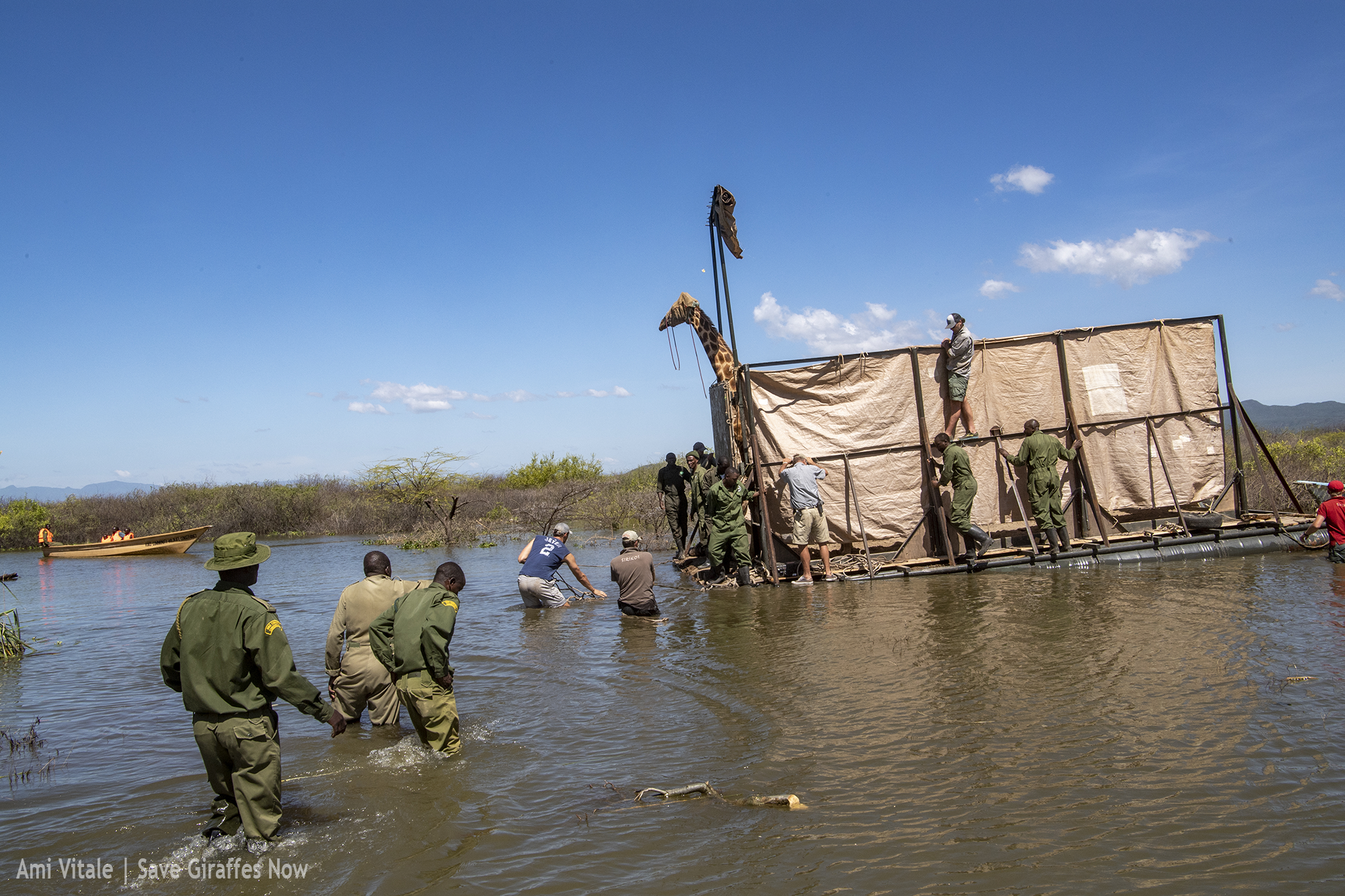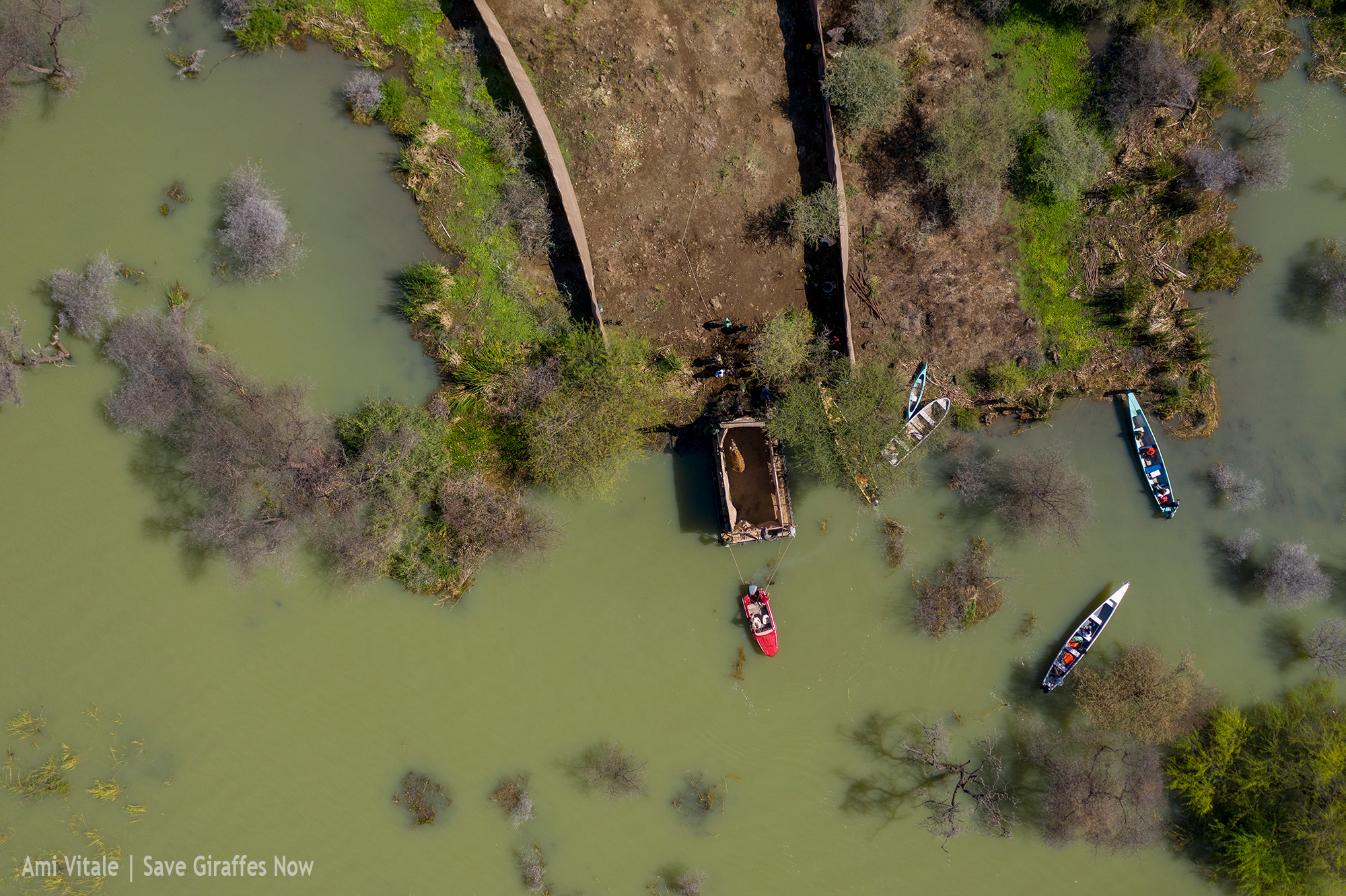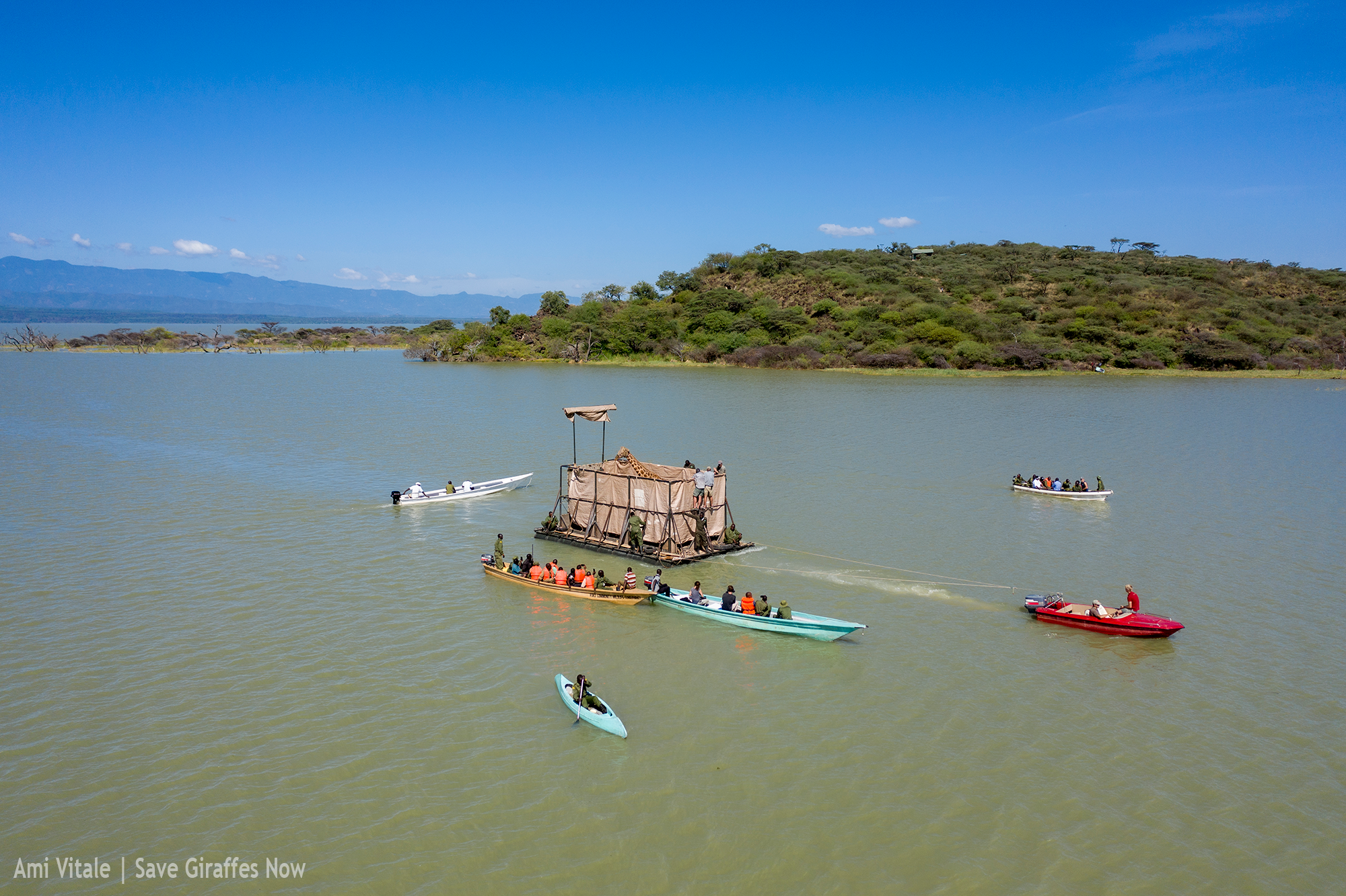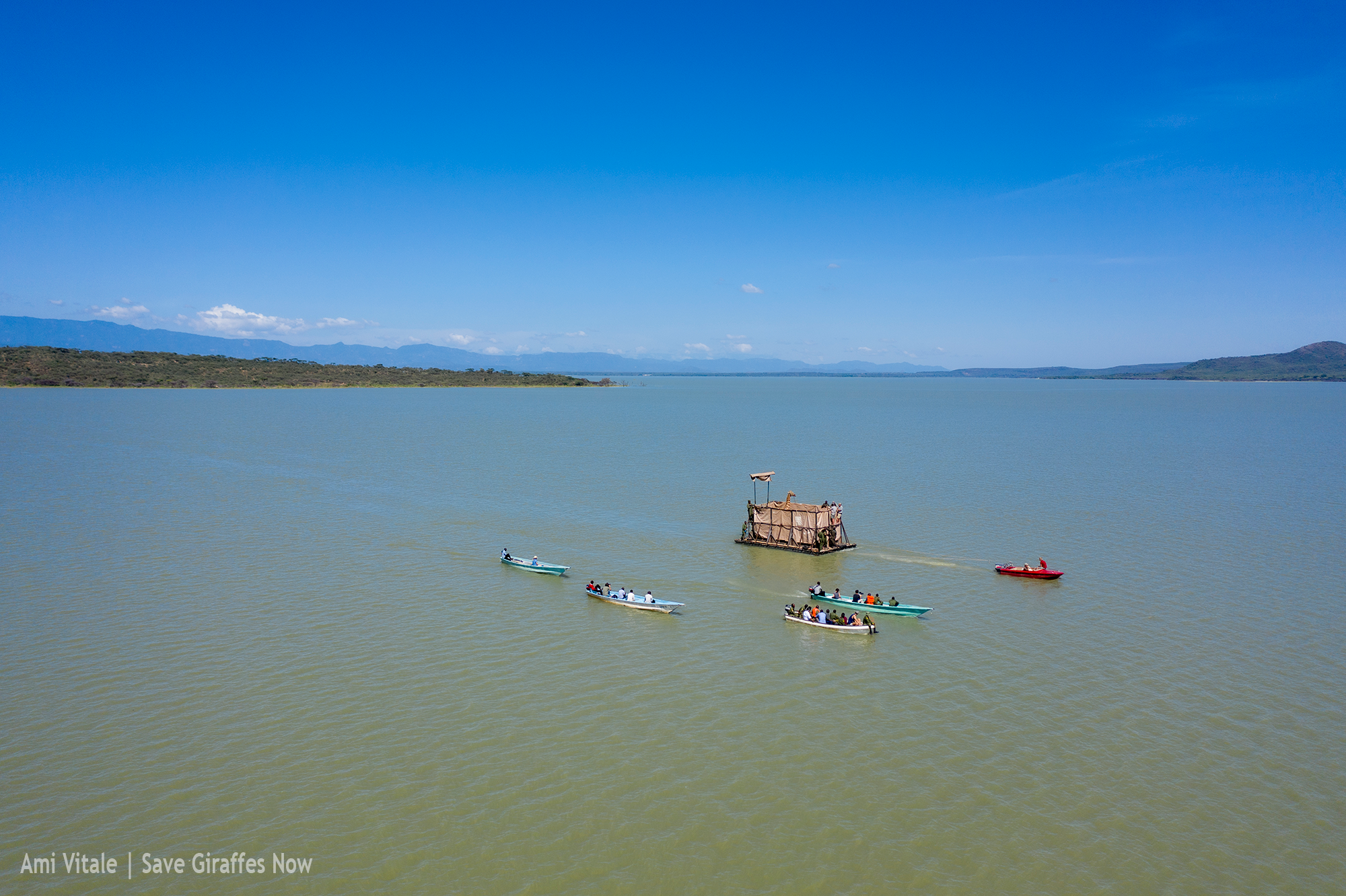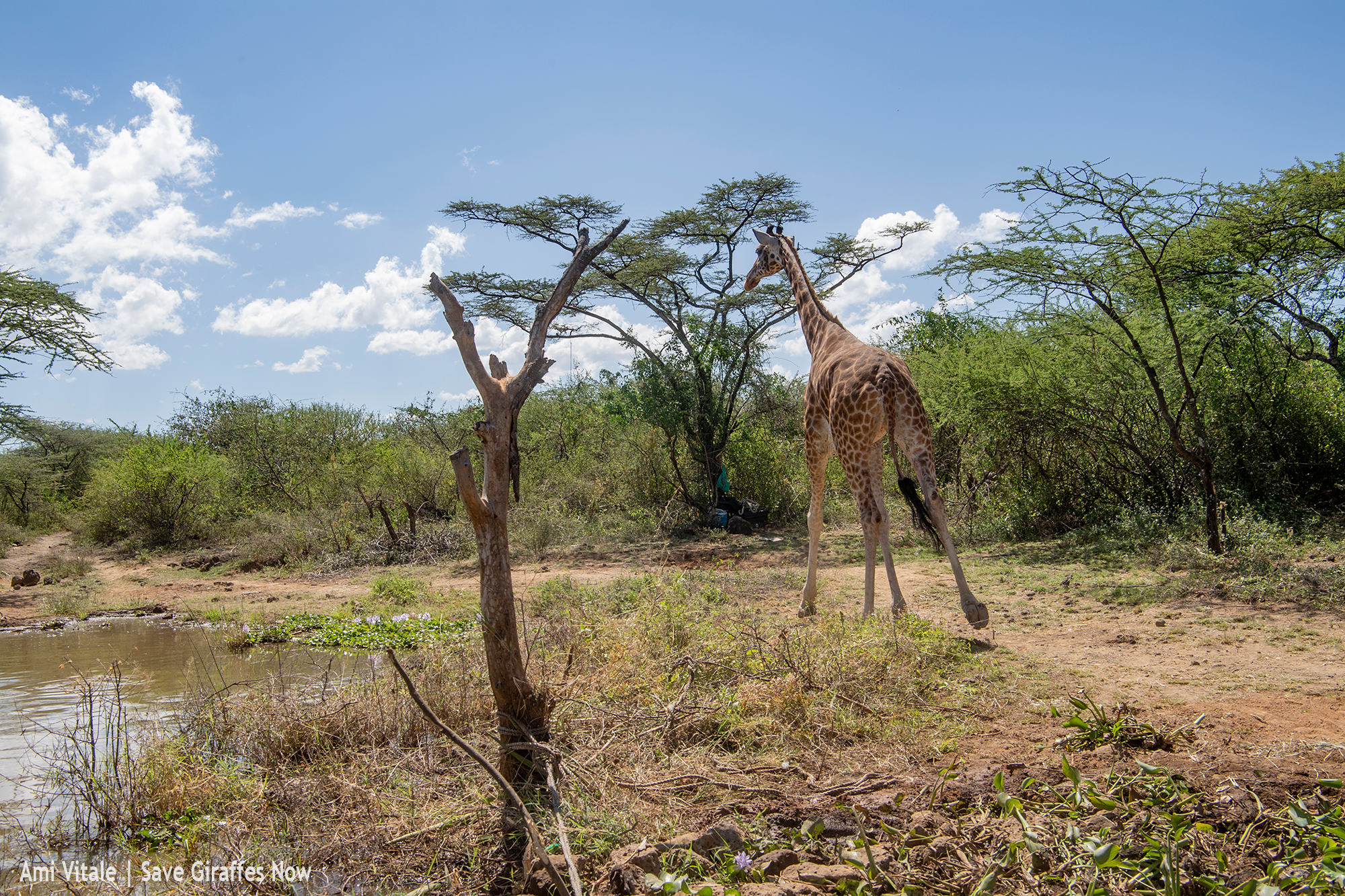Critically Endangered Rothschild Giraffe Rescued from ‘Disappearing’ Island
‘Asiwa’ - one of the stranded giraffes - is floated to mainland safety at Ruko Community Conservancy. PHOTO: Ami Vitale/ Save Giraffes Now
Kenya Wildlife Service and Ruko Community Conservancy partner to save critically endangered Rothschild’s giraffe trapped on Baringo island
LAKE BARINGO, KENYA (Dec. 02, 2020)
In an ambitious rescue effort, Kenya Wildlife Service and Ruko Community Conservancy have floated one Rothschild’s giraffe from Longicharo Island, on the eastern shores of Lake Baringo, to the mainland of the Conservancy, as rising lake levels threaten the giraffe’s future. The move was a partnership with the Northern Rangelands Trust and the US nonprofit Save Giraffes Now. Seven giraffe remain on the island. Two are due to be moved over the next few days, the rest in the next few months.
The giraffes were originally moved to Ruko in 2011, in a bid to reintroduce Rothschild’s giraffe, also known as the Baringo giraffe, back to their endemic range. Today, fewer than 3,000 Rothschild’s giraffe are left in Africa, with about 800 in Kenya. The giraffe came to epitomise the transformational impact of nurturing peace through the community conservation model, as the previously conflicting Il Chamus and Pokot communities came together under one community conservancy – Ruko - to protect them.
“The re-introduction of the Baringo giraffe in 2011 to the island has been very critical, we welcomed the efforts to allow the species to come back home where it belongs and be a catalyst in part of lager efforts of finding lasting peace between the two communities. We set aside our differences to protect this unique species, of which less than thousand remain in Kenya,” says Rebby Sebei, manager of Ruko Community Conservancy.
Ruko Conservancy rangers have been supplementing the giraffe’s food while conducting routine health checks. They have been using mangoes, a favourite treat, to train them to board the barge voluntarily, eliminating the need for sedation. PHOTO: Ami Vitale / Save Giraffes Now
Approval to move the giraffes to a purpose-built sanctuary on the mainland was granted by the Kenya Wildlife Service after lake levels started to rise by an estimated 6 inches a day, turning the giraffe’s original home into an ever-shrinking island, with remaining food sources becoming scarce. The Ruko giraffe also have faced challenges in breeding. Eight calves have been born, but just two have survived. The others are thought to have been lost to python predation, nutritional deficiencies and other natural causes – further necessitating the need for them to be moved.
The giraffes are being moved by a rectangular barge, custom-built by the Ruko community out of steel and designed to float on top of a series of empty drums for buoyancy. It has tall reinforced sides to keep the giraffes from jumping out while being tugged by boats.
”The survival of these giraffes is critical to our ongoing efforts to implement the National Giraffe Recovery Strategy to 2020-2025,” said Dr. Patrick Omondi, KWS Director of Biodiversity Research and Planning. “At the sanctuary they are safe from the rising waters and they will be protected from predators, poachers and other threats.”
Ruko Conservancy rangers have been supplementing the animal’s food while conducting routine health checks. They have been using mangoes, a favourite treat, to train them to board the barge voluntarily, eliminating the need for sedation. Lake Baringo is among the four lakes (Nakuru, Bogoria and Naivasha) lying on the floor of the Rift Valley that are experiencing an unprecedented rise in water levels.
“Each giraffe has its own personality,” said Susan Myers, founder and CEO of Save Giraffes Now, who have been working closely with Ruko. “Some are very timid, while others are brave and go onto the barge readily. This is a painstaking process, and the team has been very deliberate about the training.”
The adult female giraffe that was moved today is Asiwa. Two juvenile females, Susan and Pasaka (also known as Easter) are scheduled to be moved later this week. The four remaining adult females, Nkarikoni, Nalangu, Awala and Nasieku, and one adult male, Lbarnnoti, will be moved early next year.
Asiwa travelled well and is now getting accustomed to her new location, food and landscape in a smaller section of the 17.7 square kilometre predator-proof sanctuary, located within 44,000 hectares of Ruko Community Conservancy mainland. This will be the protocol for each giraffe moved. As they settle, the team from Ruko will then slowly release them into ever-larger areas of the sanctuary, where they’ll join other giraffe that will be re-introduced in future.
Asiwa walks to freedom on the mainland, in a purpose-built community sanctuary. PHOTO Ami Vitale/ Save Giraffes Now
“We continue to strive, work with community conservancies across northern and coastal Kenya, to enable them be resilient while sustaining their livelihoods. The exercise was a success, and we thank all partners who continue to support our noble cause through the community conservation model, a game changer in conservation not only in Kenya but also in the south of Africa,” says Aloise Naitirra Northern Rangelands Trust’s Baringo County Director.
The giraffes are not only a symbol of unity but have also provided the Ruko communities with a valuable tourism opportunity. Prior to the COVID-19 pandemic, the conservancy welcomed about 500 guests yearly, approximately 200 of whom were school children coming from as far as Nairobi to see the giraffes.
To increase tourism earnings, the conservancy has boat tours around the conservation area, raising awareness and opening the market for local entrepreneurs and youth groups around the island to sell beaded items and other wares.
Simbiri Toki celebrates after the successful transaction of Asiwa on December 2, 2020. Photo by Ami Vitale/ Save Giraffes Now
Any tourism earnings received are split 60: 40 with 40% funding conservancy operations and the 60% split equally amongst the two communities in the region for healthcare and education. Since the conservancy’s inception over 300 bursaries have been provided to schoolchildren from both communities.
Ruko Community Conservancy is one of the 39 member community conservancies supported by the Northern Rangelands Trust and Baringo County Government, through generous partnership of San Diego Zoo Global, United States Agency for International Development (USAID), Sidekick Foundation, Save Giraffes Now, The Nature Conservancy (TNC) and the Embassy of Denmark in Kenya and Somalia through DANIDA.
“In 40 to 50 years, we hope to have repopulated the entire western Rift Valley through the chain of community conservancies,” David O’Connor, the president of Save Giraffes Now said. “It’s unthinkable to imagine an Africa without giraffes, and this rescue may well help ensure the future of this species.”
In a trial run for the larger move, several other animals recently were successfully relocated to Ruko, including two rather aggressive ostriches and a handful of impala and warthogs.
About Ruko Community Conservancy
Ruko Community Conservancy is a community-based organisation, created to support the management of community-owned land for the benefit of household livelihoods and for the conservation and protection of natural resources, particularly the Rothschild’s (Baringo) giraffe. It is home to the Il Chamus and Pokot communities, who work to build strong governance and peace structures, grow diversified local businesses linked to conservation, implement community-led development programmes and manage natural resources for people and wildlife alike. Ruko is one of 39 community conservancy members of the Northern Rangelands Trust.
About KWS
Kenya Wildlife Service (KWS) is a state corporation that was established by an Act of Parliament (Cap 376), now repealed by WCMA (2013), with the mandate to conserve and manage wildlife in Kenya, and to enforce related laws and regulations. KWS undertakes conservation and management of wildlife resources across all protected area systems, including community conservancies in collaboration with stakeholders.
About Save Giraffes Now
Save Giraffes Now is a registered 501(c)(3) non-profit committed to saving giraffe from extinction by supporting action-oriented projects with immediate impact. Headquartered in Dallas, Texas, with a base in Nanyuki, Kenya, Save Giraffes Now (SGN) creates awareness about the significantly declining giraffe populations in Africa and supports on-the-ground programs, such as de-snaring/anti-poaching efforts, rewilding, and community-led projects, to ensure a stable future for the iconic giraffe and the people who live alongside them. All donations to Save Giraffes Now go directly to projects in Africa. For more information, visit www.savegiraffesnow.org.
About NRT
The Northern Rangelands Trust is a community conservancy membership organization that works for 39 community conservancies across northern and coastal Kenya. With support from principal donors USAID, The Nature Conservancy, DANIDA, and the European Union - NRT and the community conservancies are transforming lives, building peace and conserving natural resources. This indigenous movement is empowering communities to develop locally-led governance structures, implement rangelands management and wildlife conservation programmes, identify and lead development projects, and manage sustainable businesses linked to conservation. Their success has helped shape new government regulations on establishing, registering and managing community conservancies in Kenya.
